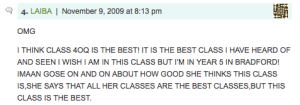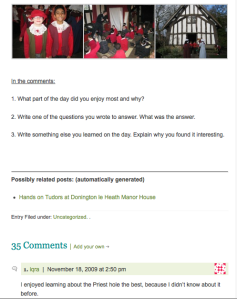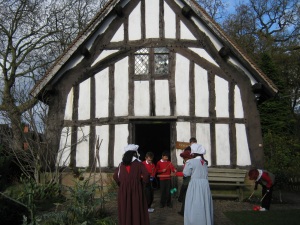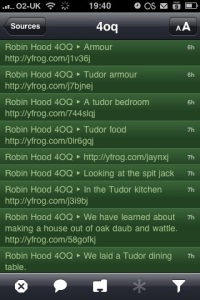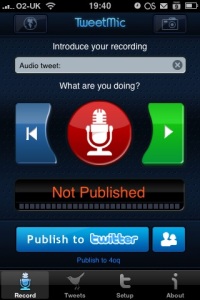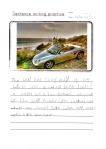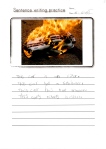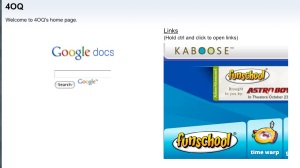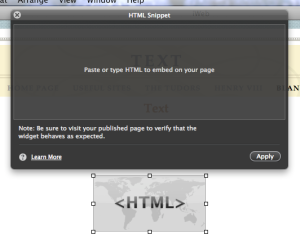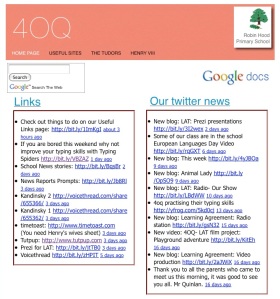This blog has moved and will not be updated any more so if you want to continue reading please update any bookmarks or subscriptions to the new blog at:
Scaffolding negotiated projects
January 11, 2010This year at our school we have been working on implementing negotiated learning in Key Stage 2. For the past few years our school has been introducing the use of curriculum content negotiated with the children from the Foundation stage up, and this approach has this year been introduced in Year 2. Further up the school we are incorporating some of the concepts behind this into our more conventional curriculum with the first hour of every day set aside for ‘Learning Agreement Time’.
This time has been set aside for groups to work on their own project ideas, negotiated and planned with their teachers to ensure they are worthwhile and real learning is taking place. Over the last term in year 4 this has resulted in many successful projects (a few examples are here). The children involved have worked on a wide variety of skills, from technical skills in the radio station, speaking and presenting, script writing and I.C.T. skills.
Recently the year 4 team have been reflecting on the direction we have taken this and decided that whilst valuable learning has been going on, what we really need to be concentrating on in this time is the skills of conceptualising, planning and managing projects. In order for the children to be able to achieve the vision of truly child-centered learning in these projects they need to be equiped with these skills, and we have decided to shift our emphasis away from learning outcomes in the projects themselves, and towards these more abstract skills.
To achieve this I really think we need to develop some kind of framework for this kind of work. Something along the lines of the frameworks provided by Alan Peat for scaffolding literacy skills. When we began Learning Agreement in September many of my class had no real idea what could constitute a ‘project’, and it has taken focused work for them to begin to generate ideas for things they could do which follow their own interests. Now that they have all experienced working on a couple of specific projects, to move forward they need to start understanding the process that they need to go through to take them from ideas generation, to planning, to a finished outcome, and reflecting on the process they have been through. Thus, I am trying to come up with some kind of abstract framework which we can use to scaffold the children in undertaking this kind of work.
For this to be of maximum benefit I think this framework needs to be something that can be universally adapted to a wide variety of project processes and outcomes. Ideally it also needs to have a progression that the children can use to enhance their project skills as they move from years 3 to 6, developing their independence and the scope of their work as they do so.
I have a few ideas, but I am really blogging about this to invite comment from other educators to supplement and challenge my thinking before we begin to develop this.
What stages do you think are essential to successful project work?
How could we integrate a progression into our framework?
Can we expect to design a framework flexible enough for true child-initiated learning?
Does the concept of such a framework go against the values of child-initiated learning?
e-Reading: Seeing books differently
January 7, 2010
During guided reading yesterday I was sharing a book of short stories with one of my groups who find reading challenging. We looked at the contents page and I asked what it was. One of the boys confidently replied, “I know, it’s the home page”. He continued to describe that the page contained “links” which “take you to” the different content in the book.
To me this offered a fascinating glimpse into the way he sees books, with some interesting implications. When I see a book of short stories I see it as a linear text. Granted, you can read the stories in a different order but I still see it essentially as a book with a start and a finish. My pupil’s comment made me realise that to him it is conceptually a non-linear text, potentially to be dipped in and out of like a website. At the age of 8 he has assimilated the conventions of a web text and appears to be bringing this abstract concept to bear on his developing understanding of more traditional media.
Although it feels like a bit of a paradox I find myself trying to explain old media to these pupils by comparing it to new; something which is difficult for those who have not grown up with technology to do. When introducing the class to email the best concept they could find to explain it was not as an electronic letter (which most of the visual clues in email software are based on). Instead it was described as ‘like a text message on a phone but longer and on your computer’.
To quote an old Apple slogan, these children really do ‘think different’.
Edublog awards nomination
December 10, 2009Our class blog for 4OQ has been nominated for the Edublog awards. Really great news as we have not been doing it very long, but it is really nice to see people sharing and taking something from what we are doing.
If you would like to give us a vote then head here.
Thanks!
Blogging in the Primary Classroom
November 22, 2009For some time now Robin Hood School has been working on developing the use of blogging in the classroom, and the abundance of class blogs was something which attracted me to the school in the first place. In our school every class has their own blog, which is set up by the ICT co-ordinator with an account for each teacher. The blogs are used to different degrees and purposes by different staff, and they have primarily been used for reporting events that are significant to each class, as a way of sharing what they are doing with parents, each other, and the world. This purpose has been very successful, with the blogs given prominence on the front page of the school website, and a significant number of hits.
I strongly feel that tools such as blogs should be used to extend learning, rather than just to teach children the skills of ‘blogging’, so after using our blog for a few weeks I took a step back and evaluated what it was I really wanted them to get out of using the tool. I decided on two main purposes for our blogging. The first was to provide an audience for our work, much as had been done before, but focusing on sharing the work itself rather than just reporting on it. I strongly believe in the social constructivist notion of authentic learning, that is that children should be provided with real experiences in order to allow them to bring meaning to what they are doing in school and create true understanding. On a practical level, producing a piece of work for a real audience is likely to encourage more motivation, and hopefully deeper thinking as a result of wanting to produce the best finished product.
The second thing I wanted the blogs to achieve was reflection from the children. Talking about the lack of time for reflection in the current packed curriculum is becoming something of a cliche, but it is true that meaningful reflection is not an easy thing to accomplish with primary age children. Blogging should be a tool that encourages this, as it allows the posting of an item or idea, and asynchronous reflection on it through the medium of comments.
Objectives set, I began by expanding what we were sharing in the blogs from photographs and reporting of ‘events’ to specific pieces of work which the class have produced. I also emphasized the authenticity of the work we were doing by sharing with them the hit count, and promoting the blog on my own twitter feed to encourage some comments from outside of our school community.The children were thrilled with comments on work such as their Tudor dance from people outside of the school. They have also been using it to show parents and family what they have been doing at school. We have even also had comments from children at other classes in our school, and even from cousins who attend other schools in different parts of the country.
I then used the blog with the class as a whole to reflect on the work. Rather than accessing it from what was stored on my own computer I showed them where they could find it online, and modeled the process of reading, evaluating and commenting by transcribing their oral evaluations as comments on the blog. This encouraged lots of children to start looking at the blog in their own time, something which I think was helped by the setting up of our class website, which they seem to really feel ownership of.
We shared lots of work, and used looking at the blog as a plenary or review activity in a number of lessons. Whilst the children were producing quite evaluative comments orally when discussing the posts in lesson time, their independent written comments were still lacking in any real focus. Therefore, I decided to start helping them to structure their responses by providing an ‘In the comments..’ activity with suggested focus for responses at the end of the blog posts. I introduced this this week with the post on our trip to a Tudor house, and set commenting on the blog as an activity in our History lesson on Wednesday.
This resulted in a terrific response, and saw our blog get 256 hits in a single afternoon. Each time we work on a web based activity in class it seems to inspire more pupils to continue the work after school and we have quite a number now who revisit our class work as soon as they get home. Granted, many of the comments left are not that evaluative, or even answering the questions, but I intend to spend some time reflecting on their reflections as a class, and I am excited to see how this develops as they evaluate and model reflection to each other.
Eventually I would like to expand this communal reflection to a more personalised reflection with the development of either learning journals or digital portfolios based on a blogging platform.
My first ideas was the development of learning journals, where the pupils would have their own blog (possibly private but shared with me, or our class) in which they could regularly record what they had been doing at school and what they had learned. The fact that we have 1 netbook per child in our class should make this very manageable, and could be very valuable in terms of encouraging them to evaluate their own learning and think more deeply about it.
The second idea was more in response to a problem than a point of learning. As we are starting to do more and more work using different web 2.0 tools as part of our school drive to utilize the entire web as a VLE, pupils work is increasingly scattered across different sites. The longer this continues the more likely it is that pupils records of learning and improvement which is served so well by traditional folders and exercise books could be lost. As increasing numbers of these services allow users to embed their work in other sites and tools, a blog could be a powerful way of collating the work pupils do across different tools into one place. This would allow us to replicate the strength of exercise books in keeping a record of learning, but could also encourage reflection as children could return to older work to comment and evaluate, bringing to it their later learning.
Perhaps a hybrid of the two is what we really need, and I would be interested to see examples of how others may have used blogs in this way to help me come to a conclusion about where I am taking this next.
In many ways I think we are a long way from fully achieving what we can with the technologies we are using in terms of childrens learning beyond the world of ICT. However after a whirlwind half term getting to grips with my teaching and the abundance of ICT in our school I am starting to see where I need to go to develop what I am doing to achieve the enhancement of learning through technology I believe in.
With all of the superficial reports in the national press about children being ‘taught blogging’ and twitter instead of traditional subjects, I think it is ever more important to reflect on what we are trying to achieve with these tools. Given the pace of change in technology, the mechanics and etiquette of blogging may well be dead in a few years. However, if we can utilize these tools to provide children with transferable and valuable learning, such as the reflection and skills I have detailed here, then the effects of their use will far outlive their lifetime as a medium.
Links
Class 4OQ’s Blog – My class’ blog
Robin Hood blogs – Class blogs from our school
Porchester Junior School – Using blogs as digital portfolios
Digitalteacher.co.uk – Detailing the setup of the above.
Sentence writing with pictures
October 17, 2009In the last few weeks I have been discussing IEP targets with children in my class (Year 4). A number of them have targets relating to writing simple sentences, and had been set targets last year to have regular practice writing sentences to go with pictures they were given. This struck me as a good idea, and is something I have done before with my year 2 class on the advice of my fantastic PGCE tutor Kate Glavina.
However, I had an interesting conversation with one of the more streetwise boys when I suggested this. He took offense at the suggestion he couldn’t write ‘simple’ sentences, and when I suggested the picture writing his response was along the lines of “Not again, that’s baby’s work writing about those pictures of girls!”. I asked him what he liked, and he replied immediately ‘Cars! Hummers, Porche’s and Lambourghini’s!”. Therefore, much to his amazement, we made the deal that if I found him some cool pictures of cars, then he would write me some cool (not simple) sentences.
Due to the fact other things got in the way, we didn’t get round to making this happen for a week or so. Throughout that time he was asking me when he was going to do his ‘car work’, and soon some other children were asking me as well…
Last week I put together the pictures. I am a big fan of Compfight.com, a search engine that lets you search for high quality images which are creative commons licensed. It was obvious from our conversation that these pictures needed to be exciting and engaging, so I used compfight to find a set of pictures which I hoped would genuinely engage him and the rest of my reluctant writers. I feel strongly that you need to have high production values for things you make for the classroom, so I used Apple’s Pages to put together a sheet that would complement these exciting pictures.
Last week we began, and the results have been fantastic! There was great excitement when I revealed the full colour pictures I had printed for them, and a genuine scramble for children to get the ones that grabbed their interest (some had chosen to go for wildlife rather than cars as their subject). The best part is that in two short sessions several of the pupils who were making no attempt to organize their ideas into sentences have started to do so. We still have a lot of work to do, but they are really starting to try to improve their writing as they want to do their best at this activity. Our last session ended with them all imploring me to let them take them home, something which really surprised me coming from these children. “My Mum will work on it with me because she loves cars too and she will remind me to do my car work.”
Just a simple idea, but one I thought was worth sharing. It just shows how taking some time to listen to children’s interests can reap rewards in terms of their engagement and effort. Hopefully, as this is something they have engaged with well, they will be willing to return to it to try to edit and improve their sentences.



 Posted by oliverquinlan
Posted by oliverquinlan 



